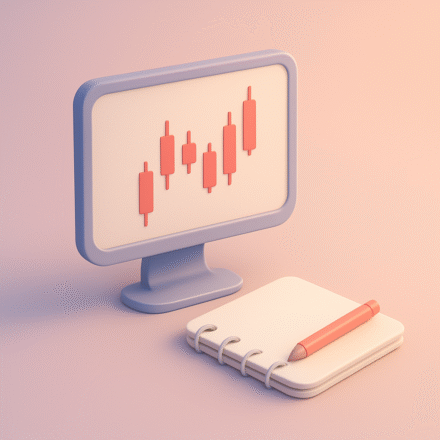How to Handle Losing Trades Like a Pro: A Realistic Guide for Beginners

Every trader faces red days — the question is: what do you do when they happen?
Table Of Content
- Let’s Be Honest — Losing Hurts
- Step 1: Don’t Panic. Breathe.
- Step 2: Did You Actually Break the Rules?
- Step 3: Journal the Trade (Even If It Feels Awkward)
- Step 4: Don’t Turn One Loss Into a Story About Who You Are
- Step 5: Review, Adjust, and Move Forward
- Red Doesn’t Mean You’re Failing — It Means You’re Learning
- Quick Recap: 5 Steps to Handle a Losing Trade
- Final Thought for Beginners
- FAQs: How to Handle Losing Trades Without Falling Apart
- Is it normal to feel emotional after a losing trade?
- What is revenge trading and why is it dangerous?
- How does journaling help after a loss?
- Should I change my trading system after a few losses?
- How can I become more emotionally resilient as a trader?
Let’s Be Honest — Losing Hurts
Your first losing trade hits deeper than you expect. It’s not just a red number on a screen, it feels like a punch to the gut. Your chest tightens. You replay the entry, the exit, the hesitation, wondering where it all went wrong. Maybe you even whisper the question you’re afraid to say out loud: Am I even cut out for this?
Here’s the truth: you’re not alone. Every trader, no matter how long they’ve been in the game—has felt that same sting. Five years in, and the losses still hurt. The difference is, seasoned traders have learned something most beginners haven’t yet: the market doesn’t reward perfection. It rewards patience, discipline, and emotional resilience. And that begins with how you handle the red days.
Step 1: Don’t Panic. Breathe.
The moment you close a losing trade, your instincts will scream: Fix it. Get it back. Prove you were right.
Don’t listen.
That impulse to re-enter the market, to chase the loss and make it “right”, is called revenge trading. And it’s one of the fastest ways to turn a small mistake into a full-blown disaster. Think of it like this: the market just pushed back. Jumping back in is like trying to fight the ocean. You won’t win, you’ll just drown faster.
Instead, interrupt the spiral:
- Stand up. Physically move. Break the trance of the screen.
- Step away. Give yourself space from the tension, the noise, the urgency.
- Take a breath. Not a metaphor. A real, slow inhale. Then another.
- Say this to yourself: “I don’t need to fix anything right now.”
That pause, however small—is powerful. It gives your logical brain time to re-engage before your emotions take over.
Step 2: Did You Actually Break the Rules?
Not all losing trades are bad trades. Some of the best trades you’ll ever take—clean setups, proper risk, good timing, will still end in red. That’s how probability works. No edge wins all the time.
Before you spiral, slow down and ask:
- Did I follow my plan? Or did I go off-script?
- Was the position size within limits?
- Was the trade emotional or intentional?
If you followed your rules, then you did your job. The trade didn’t work this time. That’s all. No shame. No self-punishment.
If you didn’t follow your rules? That’s a signal—not of failure, but of something in your process that needs attention before it becomes a pattern.
Step 3: Journal the Trade (Even If It Feels Awkward)
After a loss, journaling might be the last thing you want to do. But it’s one of the most effective ways to grow.
Your trade journal doesn’t need to be fancy. Just honest. Start with these questions:
- What setup did I see?
- Why did I take it? Was it part of my plan, or a reaction?
- What was I feeling? Calm, rushed, hesitant?
- What happened, and what can I learn?
This habit builds emotional awareness and pattern recognition. Over time, it helps you avoid the same emotional landmines and see which setups or behaviors consistently cause trouble.
And remember: you’re not journaling to look good. You’re journaling so the same mistake doesn’t keep costing you.
Step 4: Don’t Turn One Loss Into a Story About Who You Are
A losing trade often feels like a reflection of who you are, but it’s not.
For beginners, that red number can spiral into identity traps:
- “I’m not good at this.”
- “I always mess it up.”
- “Maybe I’m not built for trading.”
These thoughts aren’t truth—they’re fear. And they’ll hijack your confidence if you let them.
A single trade doesn’t define you. A red day doesn’t mean stop. It means pause. Breathe. Review. Learn.
The best traders aren’t fearless. They’re just practiced at separating outcome from identity.
Step 5: Review, Adjust, and Move Forward
Once the emotion settles and your notes are written, ask the most important question: What now?
Try these:
- Was the loss part of my plan? If yes, move on.
- Did I break a rule? Identify it. Write it down. Lock it in.
- Can I make a small adjustment? A tweak—not an overhaul.
Beginners often fall into “system hopping,” rewriting their entire approach after one bad day. That’s a trap. What you need is refinement, not reinvention.
Red Doesn’t Mean You’re Failing — It Means You’re Learning
Every trader loses. It’s not the red that defines you, it’s how you respond.
Handled well: A loss is a lesson, a stepping stone, a sign of growth.
Handled poorly: It becomes an emotional trigger, a downward spiral, a reason to quit.
The real question isn’t, “How do I avoid losses?” It’s: “How do I handle them when they come?”
The ones who go the distance don’t panic. They don’t personalize. They don’t run. They face the red. They learn from it. And they keep showing up.
Quick Recap: 5 Steps to Handle a Losing Trade
- Pause. Don’t chase. Step away and reset.
- Review your rules. Was it a good trade that didn’t work?
- Journal it. Capture the what and the why.
- Don’t personalize it. You are not your P&L.
- Adjust, then move forward. One lesson at a time.
Final Thought for Beginners
If you struggle to stay calm after losses, trade smaller. Scale down. Focus on the process—not the profit. You’re not building a highlight reel. You’re building skill, discipline, and emotional control.
And those things take time. You’re not behind. You’re just beginning.
FAQs: How to Handle Losing Trades Without Falling Apart
Is it normal to feel emotional after a losing trade?
Yes, completely. Even experienced traders feel the sting of red days. The key is learning to process those emotions constructively, rather than reacting to them impulsively.
What is revenge trading and why is it dangerous?
Revenge trading is when you jump into another trade immediately after a loss to “win it back.” It’s driven by emotion, not logic, and often leads to larger losses.
How does journaling help after a loss?
Journaling helps you review trades objectively. It builds awareness around patterns in your decision-making, especially emotional triggers that lead to bad trades.
Should I change my trading system after a few losses?
Not necessarily. Losses are part of any strategy. Focus on consistency and review small adjustments instead of overhauling your approach too quickly.
How can I become more emotionally resilient as a trader?
Start by accepting that losses are part of the process. Use tools like trade journaling, risk control, and mindfulness to build emotional discipline over time.
Found this helpful? Feel free to bookmark it, share it with fellow traders, and follow along for more straightforward, experience-based insights. I’m here to share what I’ve learned along the way — no hype, just honest trading lessons.




